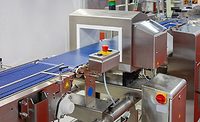How the Food Traceability Rule will Impact Food Processors—Part 1
What are food processors doing to prepare for compliance with the FDA Food Traceability Rule in 2026, and how do they see it affecting their businesses?

Image credit: SDI Productions/E+ via Getty Images
In November 2022, the U.S. Food and Drug Administration (FDA) published its Final Food Traceability Rule, Requirements for Additional Traceability Records for Certain Foods,1 as mandated by Congress under FSMA Section 204.
As stated in the rulemaking announcement released by FDA, the Traceability Rule requires companies that manufacture, process, pack, or hold foods listed on the Food Traceability List (FTL) to maintain detailed records on their supply chain and suppliers, including "Key Data Elements" (KDEs) about how those supplies are handled and processed. The Traceability Rule regulates processors of foods on the FTL, which include fresh-cut fruits and vegetables, shell eggs, nut butters, ready-to-eat deli salads, cheeses, and seafood products. The Traceability Rule applies to foods on the FTL, but a further stated aim of the rule is to encourage the voluntary adoption of these tracing records for all food products.
It is easy to see that the Traceability Rule will have a wide-reaching impact on those food companies that produce foods listed on the FTL. However, the Rule will also have a significant impact on many other companies, regardless of whether they produce foods on the FTL, due to supply chain conformity or the imposition of commercial requirements from their customers.
For this issue's column, we wanted to find out more about food processors' thoughts on the Food Traceability Rule, the impact it will have on their businesses, and what they are doing to prepare for current expectations and for eventual full compliance with the Traceability Rule by the three-year deadline.
To find out the answers to these questions, we conducted a survey and interviews with approximately 100 companies within the U.S., Canada, and 13 other countries across eight major processing categories. Of the companies that were part of our investigation, roughly two thirds—73 percent in North America and 67 percent international—said that they are FDA-regulated facilities (Figure 1). Of those in North America, 88 percent said they are aware of the changes proposed by the Rule (Figure 2). We found a lower level of awareness among international companies, with fewer than 50 percent saying they are familiar with the requirements, at the time of the survey.
FIGURE 1. Are You an FDA-Regulated Facility?
FIGURE 2. Are You Aware of the Changes Proposed by the FDA Food Traceability Rule?
Roughly one third of all facilities (Figure 3) said they produce products on the FTL (although this may be underreported, as about the same percentage said they did not know), and 57 percent said they thought the Traceability Rule would eventually apply to other foods not listed on the FTL.
FIGURE 3. Does the Food Traceability Rule Apply to You?
We also wanted to find out processors' top concerns about the Traceability Rule and the responsibilities it will impose for compliance (Figure 4). Of those companies indicating that they are familiar with the rule, their top concerns are around application and enforcement. The comments in this category mainly concerned which foods fall under the Traceability Rule and how FDA will approach enforcement for products that appear to be covered under the FTL but are not precisely defined in the text of the Rule.
FIGURE 4. What are Your Top Concerns about the FDA Food Traceability Rule?
As stated earlier, the Traceability Rule covers a number of high-risk foods listed on the FTL. These foods can be ingredients or final products, and can exist in the supply and processing chain in a number of forms. Many survey respondents questioned which foods are specifically addressed by the Rule and what happens when a food or ingredient is potentially covered in one form but may be changed during processing to a form that is potentially not covered. Are these foods still "high-risk," according to the spirit of the Rule, in the way that these processors are using them? How will FDA define these products when they are used in another way, other than the exact form as described in the Rule?
One processor commented, "We are unsure when the foods are sufficiently changed to no longer match what is described on the FTL and at what point are foods not considered 'fresh.'" Another added color to the topic by mentioning, "In our processes, we often use both whole and diced tomatoes and sometimes switch between both in a single production batch. The Rule doesn't take into account that during the manufacturing process, the whole tomatoes break down and become indistinguishable from diced tomatoes, essentially making the ingredient description irrelevant."
Another processor questioned the applicability of the Traceability Rule to its specific operation. The Rule defines applicability to include "…companies that manufacture, process, pack, or hold foods listed on the FTL…" This respondent said, "We are a nonprofit food bank distribution center. Does this Rule apply to us?" Another asked, "We are a distribution center only, and we do not change or process the food while in our possession. How does this Rule apply to us?"
The Rule also makes provisions for facilities to apply for an exemption. Several companies, especially distributors in a similar situation to the one referenced above, asked, "What will be the process to prove and maintain an exemption if one is allowed?" These types of questions about the applicability of the Traceability Rule run hand-in-hand with those directly related to enforcement in terms of who is required to do what, the type and intensity of enforcement to be expected, and how companies should prepare before the 2026 compliance dates.
Another theme that emerged from the enforcement questions was asking for help from FDA. Companies are eager for help in getting suppliers to understand and comply with the requirements of the Rule so that processors, especially smaller ones, are not put in the position of being responsible for educating several layers of their supply chain in compliance requirements of the Rule, or face penalties. If FDA implements strict levels of enforcement for suppliers and producers of end products, then end-product producers can be more confident that getting the data they need from their supply chain will be easier and the responsibility for education, awareness, and enforcement of the Rule will not fall on their shoulders. As such, many companies are looking for a high degree of outreach and education from FDA for everyone in the supply chain, so that all are aware of the Traceability Rule and understand its requirements.
The second most-cited concern has to do with compliance requirements. This series of comments can be simplified to, "What, specifically, needs to be done in my situation, and how do we get it done?" Many mentioned that without further clarity of all the steps required, it will be difficult to perform a gap analysis between current practices and Traceability Rule compliance. One processor wants to know, "Are our current practices not sufficient enough to match some of the KDEs being maintained?" Another asked, "What requirements for our suppliers are different from the requirements for our third-party auditors?"
The main topics within processors' remaining major concerns can be characterized as elements of the execution of their eventual plan, concerns about the complexity of the programs and recordkeeping needed, and important considerations on additional staffing and costs required to comply with the Traceability Rule.
Only 5 percent of processors said they had "no concerns" about the Rule.
As anxiety-producing as these questions and concerns may sound, 87 percent of companies said that a three-year compliance timeframe was reasonable (Figure 5), with only 11 percent indicating "maybe or not sure" on the timeframe. Of the 87 percent who agreed, many said that they believed they had many of the necessary pieces already in place. One vegetable processor mentioned, "Three years is reasonable… most growers have already implemented the Rule." An infant formula producer said, "Yes, I believe we are already compliant; if anything, it will require minor changes."
FIGURE 5. Is the Three-Year Compliance Timeline Reasonable?
Others seemed to be comfortable with the three-year timeline, but added caveats to their answers. "It depends on the technology that is needed to assist in this process," said a quality assurance/control manager at a ready-to-eat meal producer, while a quality assurance/control manager at a dietary supplement manufacturer opined, "Three years is typically enough time to update a procedure."
A food safety specialist at a fruit and vegetable processor was less convinced that the three-year compliance deadline was reasonable, saying that FDA will have a big role to play in the achievement of this deadline. "I'm not sure," he said. "The FDA has not been clear about what is included in the final rule. They need to 'educate before they regulate.' FDA should hold educational sessions that clearly lay out the expectations of the law."
The April/May issue of Food Safety Magazine will include Part 2 of this investigation, where we will hear more from processors on the systems and processes they are currently using to track their supply chain and suppliers, and how they plan to adjust or upgrade their systems to address the added demands of the Traceability Rule. We look forward to bringing those perspectives to you in the next Food Safety Insights.
References
- U.S. FDA. "Requirements for Additional Traceability Records for Certain Foods." Federal Register, 87 FR 70910. November 21, 2022. https://www.federalregister.gov/documents/2022/11/21/2022-24417/requirements-for-additional-traceability-records-for-certain-foods.
Bob Ferguson is President of Strategic Consulting Inc. and can be reached at bobferguson9806@gmail.com or on Twitter at @SCI_Ferguson.
Looking for a reprint of this article?
From high-res PDFs to custom plaques, order your copy today!






